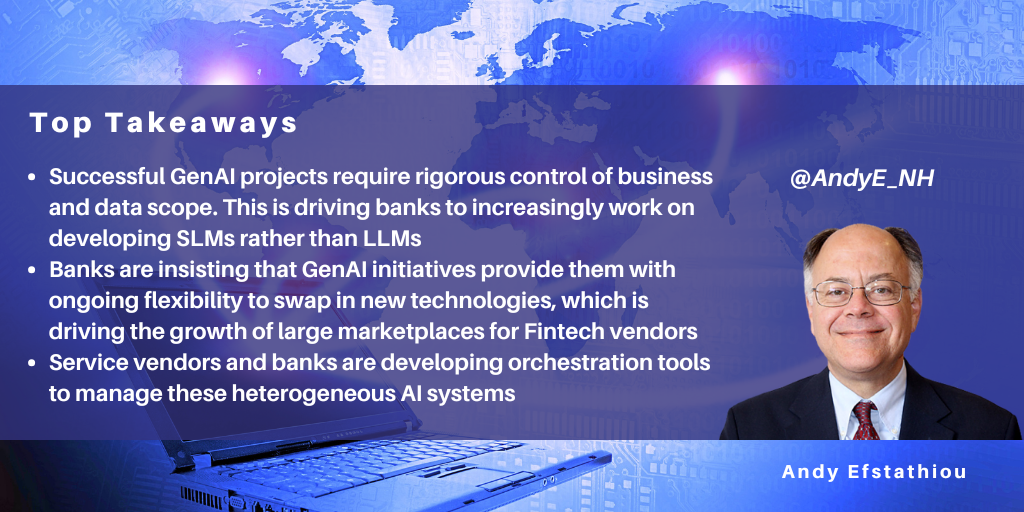posted on Oct 28, 2025 by Andy Efstathiou

I recently completed a global market assessment of how GenAI and process automation are transforming banking operations. Here are some high-level findings.
GenAI adoption trends in banking
The adoption of GenAI and automation is still very immature, with large institutions being the only adopters of this technology on a large scale. However, the pace of maturation is accelerating, as demonstrated by:
- In 2024, the largest tier one banks worked on ~100 POCs each, and only 5% or fewer POCs moved through to operational deployment. However, in 2025, 25% of POCs are moving forward to operational deployment
- Tier two banks were doing only a handful of GenAI POCs each, with almost none moving forward to operational deployment in 2024. However, in 2025, tier two banks are looking for prepackaged GenAI POCs to deploy to operations. If those are successful, they expect to grow the scale of their GenAI activities in 2026
- Tier three banks are engaging in GenAI activities in two ways: enabling employees to test co-pilot agents to enhance personal productivity, but not interact with customers; and joining consortia that will develop GenAI offerings for their market niche
- Specialty financial institutions are running GenAI POCs to deliver low-volume, high-value processes. Examples include commercial banking, trade finance, investment banking, credit/investment analysis, and employee training.
The use cases being operationalized are software engineering, customer agent support, customer onboarding, credit/investment analysis, and personalized training. The majority of GenAI activity in financial services is in software engineering.
The challenge of becoming an AI-first business
Legacy financial businesses cannot become AI-first businesses without becoming fully digital, accessing relevant data as needed, and transforming legacy platforms. To accomplish those goals, banks are:
- Automating manual processes. For years, banks had automated high-volume, low-value processes to reduce costs. Now they are automating low-volume, high-cost processes, with the aim of automating all processing over the next decade. Generally, low-volume processes are for enterprise and high-net-worth customers. By automating these processes, the banks can generate clean data that can be analyzed by GenAI and agentic AI solutions
- Moving legacy systems to the cloud. Legacy transformation has been an expensive, risky, and long-term project. By moving legacy systems to the cloud, banks can break the process into smaller, less risky steps using microservices, APIs, and app marketplaces
- Adopting SLMs. Clean data is challenging to generate on a large scale. Early GenAI POCs have led banks to pursue SLMs, which are much easier and less costly to scrub and vet for high-quality data, thereby reducing the risk of GenAI hallucination.
Once processes have been digitalized and data scrubbed for a business process, such as credit analysis, the institution needs to develop a plan to change the business model, enabling the business to employ an AI-driven operational environment. As of today, only a few of the most sophisticated large enterprises are integrating business model change into their AI transformation initiatives. To achieve these transformation goals, banks are increasingly demanding change management services from vendors.
Summary
Successful GenAI and automation projects require rigorous control of business and data scope. By limiting the scope of a business process to a well-defined set of operational processes, the bank can source and analyze data effectively. A key example of this is credit analysis, which pulls in large amounts of data but performs analysis that is standardized for an individual institution. Similarly, software development consists of a series of processes that are standardized for an individual institution to create customized functionality. This is driving banks to increasingly work on developing SLMs rather than LLMs for their GenAI engagements.
The use of GenAI is rapidly evolving, and banks are insisting that their GenAI initiatives provide them with the ongoing flexibility to swap in new technologies as new leaders emerge. This creates large ecosystems and marketplaces for Fintech vendors. Service vendors and banks are developing orchestration and management systems, often under the rubric of ethical AI, to manage AI systems and report on their effectiveness.
I will publish a market assessment on GenAI and Process Automation in Banking in December that will delve deeper into this market. It will identify how the market is evolving, what services banks are buying to support their transformation efforts, and the benefits being realized.
